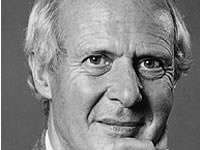Brian Barratt-Boyes
Sir Brian Gerald Barratt-Boyes KBE (born Brian Gerald Boyes, 13 January 1924 – 8 March 2006) was a pioneering heart surgeon from New Zealand.
Sir Brian Barratt-Boyes KBE | |
|---|---|
 | |
| Born | Brian Gerald Boyes 13 January 1924 Wellington, New Zealand |
| Died | 8 March 2006 (aged 82) Cleveland, Ohio, USA |
| Alma mater | University of Otago |
| Spouse(s) | Norma Margaret Thomson
( m. 1949; div. 1986) Sara Rose Monester ( m. 1986) |
Life
Born in Wellington on 13 January 1924, Barratt-Boyes was educated at Wellington College. After a year at Victoria University College, he studied medicine at Otago's Medical School, graduating in 1946.[1] He continued his training as a surgeon, initially in New Zealand, and later at the Mayo Clinic (1953–55) and as a Nuffield Fellow in Bristol (1955–56). At Mayo he worked under John W. Kirklin, the two developing a high mutual regard that endured and grew over the years.
Barratt-Boyes married physiotherapist Norma Margaret Thomson in Dunedin on 9 November 1949. The couple went on to have five sons.[1]
In 1956 he was recruited back to Auckland, New Zealand by Sir Douglas Robb, and pioneered the development of cardiopulmonary bypass in that country, the first patient being operated on in 1958. While this task must have been made more difficult by New Zealand's relative remoteness and small population, the Greenlane Hospital surgical team quickly achieved an international reputation for innovative excellence. Indeed, he suggested that Auckland's isolation conferred an advantage comparable to that enjoyed by the Mayo Clinic in small-town Rochester, Minnesota, making it less likely that day-to-day interruptions would interfere with the real purpose of their work. Much of the original equipment had to be fashioned or modified locally. Sid Yarrow, an engineer on the team, built an early external pacemaker for intra-operative use. The first permanent unit, from Medtronic, was implanted in 1961.
In 1962 he introduced, independently but simultaneously with Donald Ross in London, the human cadaveric aortic homograft for aortic valve replacement and for many years he worked to perfect valve preparation, emphasizing its inherent physiologic advantages and simplifying its surgical implant technique. He and his team's results became the standard for others to match.
In 1969 he brought the technique of profound hypothermia and circulatory arrest into the limelight as a practical method for dealing with major corrective surgery in neonates with congenital heart disease, in so doing further establishing Greenlane Hospital on the international stage. In recognition of these and other achievements he was appointed a Commander of the Order of the British Empire in the 1966 New Year Honours,[2] and promoted to Knight Commander of the same order in the 1971 New Year Honours, further confirming a national prominence comparable to that achieved by René Favaloro in Argentina and Christiaan Barnard in South Africa. Barratt-Boyes showcased the Greenlane experience at many international meetings as well as in workshops he hosted in Auckland. The 1987, Asian Pacific Congress was a particular success for him for the size of the international contingent it drew and the bright spotlight it shone on Greenlane's history of achievement. In 1985 he and John Kirklin published their authoritative text Cardiac Surgery, a colossal achievement of more than 1,500 pages that quickly became the standard reference for the sub-specialty.
In 1986, Barratt-Boyes and his first wife were divorced, and he married Australian lawyer Sara Rose Monester.[1]
Barratt-Boyes died on 8 March 2006 in Cleveland, Ohio, USA, of complications following a cardiac operation.[1] His first wife, Norma, died on 10 November 2016.[3]
References
- Wrapson, Jill (30 October 2012). "Barratt-Boyes, Brian Gerald". Dictionary of New Zealand Biography. Ministry for Culture and Heritage. Retrieved 5 March 2016.
- "No. 43856". The London Gazette (Supplement). 1 January 1966. p. 42.
- "Norma Barratt-Boyes death notice". New Zealand Herald. 12 November 2016. Retrieved 12 November 2016.
Sources
- Donna Chisholm, From the Heart: A Biography of Sir Brian Barratt-Boyes, Reed Methuen, 1987, ISBN 9780474002120
- Nicholas T. Kouchoukos; Eugene H. Blackstone; Frank L. Hanley; James K. Kirklin (26 October 2012). Kirklin/Barratt-Boyes Cardiac Surgery, Expert Consult - Online and Print (2-Volume Set),4: Kirklin/Barratt-Boyes Cardiac Surgery. Elsevier Health Sciences. pp. 9–. ISBN 1-4160-6391-9.